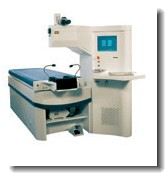
Technolas 217A Excimer Laser System: FDA Test Results
Device Trade Name: Technolas 217A Excimer Laser System
Applicant: Bausch & Lomb Surgical Inc., Irvine, California, USA.
Approved By The FDA: February 23, 2000
Applicant: Bausch & Lomb Surgical Inc., Irvine, California, USA.
Approved By The FDA: February 23, 2000
As of the date of this report, over 160 Technolas 217 Excimer Laser Systems had been installed in the following countries: Argentina, Australia, Austria, Belgium, Brazil, Canada, Chile, China, Columbia, Czech Republic, Finland, France, Germany, Greece, Hong Kong, India, Indonesia, Israel, Italy, Japan, Jordan, Korea, Malaysia, Mexico, New Zealand, Portugal, Qatar, Russia, Saudi Arabia, Singapore, South Africa, Spain, Sweden, Switzerland, Thailand, Turkey, UK, and Venezuela. The Technolas 217A Excimer Laser System has not been withdrawn from marketing for any reason relating to the safety and effectiveness of the device.
The Bausch & Lomb Surgical Technolas 217A Excimer Laser System is intended for use:
*In laser in situ keratomileusis (LASIK) treatments for the reduction or elimination of myopia between -1.00 and -7.00 diopters of sphere and less than -3.00 diopters of astigmatism at the spectacle plane;
*In patients with documented evidence of a change in manifest refraction of less than or equal to 0.50 diopters for at least one year prior to the date of the pre-operative examination;
*In patients who are 21 years of age or older.
*In laser in situ keratomileusis (LASIK) treatments for the reduction or elimination of myopia between -1.00 and -7.00 diopters of sphere and less than -3.00 diopters of astigmatism at the spectacle plane;
*In patients with documented evidence of a change in manifest refraction of less than or equal to 0.50 diopters for at least one year prior to the date of the pre-operative examination;
*In patients who are 21 years of age or older.
Summary Of Clinical Studies:
A total of 360 eyes were enrolled in this multi-center study, to ensure the targeted completion of 300 eyes.
A. Study Objective
The objectives of this study was to demonstrate the safety and effectiveness of the Bausch & Lomb Technolas 217A Excimer Laser for the correction of low myopia from -1.00 to -7.00 diopters with astigmatism of up to -3.00 diopters when used as part of the LASIK surgical procedure.
A total of 360 eyes were enrolled in this multi-center study, to ensure the targeted completion of 300 eyes.
A. Study Objective
The objectives of this study was to demonstrate the safety and effectiveness of the Bausch & Lomb Technolas 217A Excimer Laser for the correction of low myopia from -1.00 to -7.00 diopters with astigmatism of up to -3.00 diopters when used as part of the LASIK surgical procedure.
| Patient Symptoms: |
% Worse At 3 Months: |
% Worse At 6 Months: |
| Light Sensitivity | 14.6% | 10.9% |
| Headaches | 3.8% | 2.0% |
| Pain | 5.9% | 2.0% |
| Redness | 8.6% | 6.3% |
| Dryness | 20.5% | 17.0% |
| Tearing | 4.1% | 2.0% |
| Burning | 8.9% | 4.3% |
| Gritty Feeling | 7.3% | 6.0% |
| Glare | 15.9% | 10.3% |
| Halos | 25.1% | 18.4% |
| Blurred Vision | 15.1% | 10.3% |
| Double Vision | 2.2% | 2.2% |
| Ghost Images | 2.4% | 2.3% |
| Fluctuations Of Vision | 16.2% | 14.7% |
| Variation Of Vision-Bright Light | 7.8% | 6.3% |
| Variation Of Vision-Normal Light | 9.7% | 5.7% |
| Variation Of Vision-Dim Light | 14.9% | 12.4% |
| Night Driving Vision | 13.8% | 11.5% |
| Discharge | 0% | 0% |
| Edema, Lid | 0% | 0% |
| Eye Strain | 0% | 0% |
| Floaters | 0% | 0% |
| Itching | 0.3% | 0% |
| Night Vision | 0% | 0% |
Patient Satisfaction:
Responses provided by the study participants at three and six months to three questions regarding their experiences with the laser surgery are provided below. These three questions related to: 1) the perceived overall quality of vision following surgery; 2) the participant's willingness to have the surgery again if he/she could make the choice over; and 3) the participant's overall satisfaction with the results of the surgical procedure.
Responses provided by the study participants at three and six months to three questions regarding their experiences with the laser surgery are provided below. These three questions related to: 1) the perceived overall quality of vision following surgery; 2) the participant's willingness to have the surgery again if he/she could make the choice over; and 3) the participant's overall satisfaction with the results of the surgical procedure.
| Self Evaluation: |
Overall Vision Quality: |
| Would Select Refractive Surgery Again: |
Satisfaction: |
| Response: | At 3 Months: |
| No Improvement | 0% |
| Slight Improvement | 0.3% |
| Moderate Improvement | 3.6% |
| Marked Improvement | 29.3% |
| Extreme Improvement | 66.9% |
| No | 0% |
| Yes | 98.4% |
| Unsure | 1.6% |
| Very Satisfied | 91.0% |
| Moderately Satisfied | 7.6% |
| Neutral | 1.1% |
| Dissatisfied | 0.3% |
| Very Dissatisfied | 0.0% |
The overall quality of vision was rated highly, with 96.2% of patients indicating that there was an extreme or marked improvement, while only 0.3% indicated that there was only slight or no improvement; 98.4% would elect to have the surgery again; 91.0% reported being very satisfied and 7.6% reported being moderately satisfied, while only 0.3% reported being dissatisfied; and, no cases reported being very dissatisfied.
Conclusions Drawn From The Clinical Study:
The data in this application provides reasonable assurance that the device is safe and effective when used in accordance with the directions for use. The FDA issued its approval of the Technolas 217A Excimer Laser System on February 23, 2000.
The data in this application provides reasonable assurance that the device is safe and effective when used in accordance with the directions for use. The FDA issued its approval of the Technolas 217A Excimer Laser System on February 23, 2000.

B. Study Design
The core study for this submission was a prospective, open-label, non-randomized, multi center clinical evaluation conducted at three clinical sites in Canada. This evaluation was performed under a protocol submitted to FDA and in accordance with FDA requirements for studies conducted outside of the United States. The study protocol required the enrollment of at least 360 eyes in order to achieve the targeted completion of 300 eyes.
Demographics:
The distribution of male and female subjects in the study was approximately even (45.9% male, 54.1% female). Racial distribution of the enrolled patients was predominantly white, reflecting the patient population primarily found in both the Ontario and Quebec provinces of Canada. 95.9% of participants were White, 1.0% Black, 2.1% Asian, and 1.0 Other. Ages ranged from 21 to 66, with a mean age of 37.9 years.
The core study for this submission was a prospective, open-label, non-randomized, multi center clinical evaluation conducted at three clinical sites in Canada. This evaluation was performed under a protocol submitted to FDA and in accordance with FDA requirements for studies conducted outside of the United States. The study protocol required the enrollment of at least 360 eyes in order to achieve the targeted completion of 300 eyes.
Demographics:
The distribution of male and female subjects in the study was approximately even (45.9% male, 54.1% female). Racial distribution of the enrolled patients was predominantly white, reflecting the patient population primarily found in both the Ontario and Quebec provinces of Canada. 95.9% of participants were White, 1.0% Black, 2.1% Asian, and 1.0 Other. Ages ranged from 21 to 66, with a mean age of 37.9 years.
Results Of The Study:
Adverse patient symptoms that occurred in the clinical study are shown below:
Adverse patient symptoms that occurred in the clinical study are shown below:

More On Laser Eye Surgery:
Contact Lenses | Glaucoma | Just For Fun | Eyeglasses | Eye Doctor | Eye Care And Symptoms | Eye Anatomy | Online Eye Tests | Laser Eye Surgery | Laser Eye Surgery Directory: Canada | Laser Eye Surgery Directory: USA | Laser Eye Surgery Reviews | Submit A Review | Contact Us | Privacy Policy | Sitemap
Copyright 2006-2009 Vision Health

